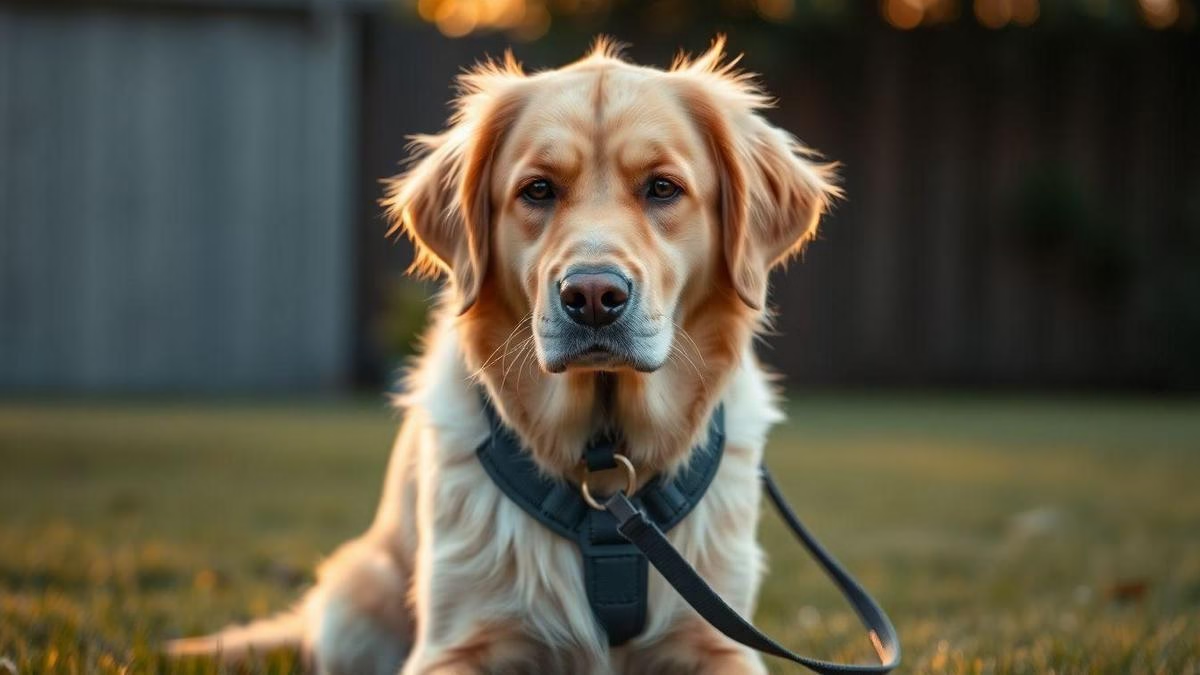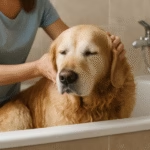How to Train Your Dog to Stop Jumping: Step-by-Step Behavior Guide — I know how hard it feels when a beloved senior Golden keeps jumping, so I use positive reinforcement and calm greetings to change the habit. I reward with small treats and praise right away so my dog links the action and the reward. I pick gentle training methods for senior Goldens because of arthritis and sore joints, keep sessions short and low impact, and check with my veterinary care team before I up activity. I teach an alternative behavior like sit or back up, practice clear door greetings, work on loose leash walking with a comfy harness and equipment suited to seniors, and add simple cognitive enrichment activities like food puzzles to lower stress. I move slowly, track small wins, and balance exercise, rest, and calm cues to protect mobility and keep training kind and effective.
Key Takeaway
- I go slow and keep it gentle
- I use soft treats and praise
- I keep training short and calm
- I adjust exercises for my senior dog
- I stay patient and celebrate small wins
I use positive reinforcement to stop jumping in my senior Golden — How to Train Your Dog to Stop Jumping: Step-by-Step Behavior Guide
I stopped scolding and chose treats and calm praise when my Golden got older. Jumping used to be a happy explosion; for an older dog, it can mean sore joints and stress. I teach a new greeting habit that keeps his paws on the floor and his tail wagging. I speak softly, move slowly, and make calm the most exciting outcome, informed by common behavioral changes in aging Goldens.
My routine is simple and repeatable:
- Prepare tiny, smelly treats and stand nearby.
- Ask for a sit or wait as the visitor approaches.
- Turn away if he jumps; reward the moment all four paws are down.
- Repeat in short bursts, several times a day.
I keep sessions short and kind—10 minutes, two or three times daily works for us—and stop if he looks stiff. This method respects his age while teaching good manners.
I reward calm greetings with treats and praise
When someone knocks, I cue “sit” and make calm the prize. I praise softly and give a tiny treat the instant his paws stay on the floor. I also train family and friends to greet him low and slow: lean down, keep treats ready, and wait for four paws. That teamwork speeds learning and helps create a calm, peaceful environment that keeps my Golden comfortable.
I time rewards immediately so he links action and outcome
Timing is everything. I use a clear marker word like “Yes!” and give the treat within a second so he connects calm behavior to the reward. When guests arrive, I ask them to pause at the door while I handle the first repetitions and reward the instant he stays put.
I keep rewards small and consistent
I use pea-sized treats or kibble so one session doesn’t fill him. Same flavor, same quick praise every time—small, consistent rewards make the lesson clear: calm = good.
I choose gentle training methods to protect joints and manage arthritis
My Golden’s hips and knees tell me when to slow down. I trade long runs for calm walks, pick low-impact activities, and focus on small wins: one sit, one calm greeting, one short walk. I watch her body closely and add ramps, non-slip mats, and raised bowls to cut strain—simple home changes explained in ways to adapt your home for a senior Golden.
I read guides and adapt techniques to be softer—shorter sits, tiny steps, and quiet praise so learning doesn’t trigger pain.
I adapt exercises to reduce pain
I choose activities that build muscle without pounding joints. Swimming is excellent: she moves with support and I gradually raise time in the water while following hydrotherapy guidance from hydrotherapy resources. Short flat walks, slow range-of-motion stretches, and gentle strength work (short hill reps, assisted stairs if allowed) help mobility without flares.
| Exercise | Intensity | Benefit | How I adjust |
|---|---|---|---|
| Swimming | Low | Builds muscle, no impact | 5–10 min, use harness, increase slowly (hydrotherapy tips) |
| Short flat walks | Low | Maintains mobility | 10–15 min, 2–3x daily (low-impact exercise ideas) |
| Slow stair/hill | Moderate | Strengthens hindquarters | 1–3 repeats, short distance |
| Passive range-of-motion | Low | Keeps joints flexible | 5 min after warm-up, gentle (canine physical therapy) |
I use short, low-impact sessions
Five to ten minutes of focused work, two or three times a day, beats one long session that tires joints. I mix mental games with light movement—nose work, puzzle feeders, simple obedience drills—so she gets tired in a good way without heavy impact. End each session on a positive note.
- Warm up with gentle walking or massage, do 5–10 minutes of activity, finish with a calm cool-down and a soft reward.
I check with my vet before increasing activity
My vet helps decide tests, pain meds, supplements, or referrals like hydrotherapy or physical therapy. I consulted resources on choosing the right veterinarian to make sure our plan fits her needs.
I reinforce house rules and leash habits to prevent jumping at doors and visitors
I set calm, repeatable steps so my senior golden reads the moment and lowers excitement before guests arrive. I pair rules with small rewards that respect his age—soft treats, gentle praise, ear scratches—and avoid high-value treats that spark bursty energy.
I manage the environment: leash on during busy arrivals, baby gates, and a non-slip mat at the door so staying calm is the practical, safe choice for everyone.
I teach clear door greetings in bite-sized steps
I ask for a sit away from the door, reward calm behavior, and only let him move forward when he stays relaxed. Consistency turns this sequence into a habit.
- Ask for sit before opening the door.
- Reward calm with a gentle touch or small treat.
- Only open the door if the sit holds.
- Praise the calm, steady approach.
- Repeat short sessions daily.
A guest who loved big hugs once visited; after a week of short practice and slow, gentle greetings, the guest could kneel and pet him while he stayed on all fours.
I practice loose-leash walking to control excitement
Short, controlled walks build calm focus. We practice loose-leash walking for five to ten minutes several times daily: stop when he pulls, resume when the leash is slack. Simple cues like easy or let’s go mean low energy. If he gets excited, I do slow circles to regain attention. For guidance on safe movement choices, I consult posts about safe, senior-friendly exercises.
I use a harness for comfort and control
A soft, well-fitted harness spreads pressure across the chest and protects the neck. I check fit regularly as weight and coat change; see recommendations for essential equipment and supplies for seniors.
| Harness Type | Good For | Note for seniors |
|---|---|---|
| Back-clip | Leisure walks | Comfortable, less control if he pulls |
| Front-clip | Pull control | Helps steer and reduce lunges |
| Padded no-pull | Support comfort | Best balance for weak joints and steady guidance |
I add cognitive enrichment to lower stress and unwanted jumping
Jumping often signals stress or boredom. Short brain games calm her and give a job to do, which cuts the impulse to leap up. I used ideas from ways to keep a senior Golden’s mind active and mental enrichment activities to shape mental work into our routine—replacing frantic greetings with a sniff search or a gentle food puzzle when guests arrive.
I use food puzzles and scent games
I pick puzzles gentle on her jaws and simple to open. Scent games—hiding kibble or a smelly sock—are low impact but high payoff for her brain. For toy ideas and puzzle options, I reference appropriate toys and puzzles for seniors.
I rotate toys and short training challenges
I swap two or three toys every few days so old toys feel new. I mix five-minute drills—sit-wait, gentle target touch, recall to a mat—into the day as quick resets. Small, frequent wins build calm habits.
I keep mental sessions brief and rewarding
Short sessions that end while she’s eager keep her engaged. My routine:
- Start with a cue she knows.
- Offer a short puzzle or scent find for 2–4 minutes.
- Reward with praise or a kibble piece.
- End on a positive note and rest.
I follow a clear step-by-step behavior plan: How to Train Your Dog to Stop Jumping: Step-by-Step Behavior Guide
I start by being honest about what my senior golden can do. Age changes energy, joints, and focus, so my plan is gentle and clear: teach a replacement action, practice in calm settings, and mark small steps forward. Break the work into bite-size moves, use the same word and reward, and watch body language—if he shows pain or stress, make the step easier. This steady approach mirrors many tips for gentle, senior-specific training plans.
I keep sessions short—three to five minutes, two to four times a day—and expect progress in inches, not miles. Little wins stack fast when I stay calm and consistent.
I teach an alternative behavior like sit or back up
I choose actions that don’t stress joints. For guests I use “sit”; for excited approaches I sometimes use “back up.” I reward the instant he performs the action. Lower my hand height and use soft treats so he doesn’t need to rear up. Over time, the cue replaces the jump because he gets something better by staying low.
I practice with controlled visits and increase distractions slowly
Start with one calm friend who knows the plan. They enter slowly, ignore the dog until quiet or sitting, then reward. Add one new challenge at a time—louder voice, more guests, an open door—and if he slips, step back to the last success and rebuild. This prevents overwhelm and keeps confidence high.
I track small wins and adjust steps
I keep a simple notebook: number of sits, length of calm greeting, any pain signs. Tracking helps me tweak distance, reward type, or session timing. When I see trends—better focus in the morning—I shift more practice there and adjust our daily wellness routine accordingly.
I balance exercise, rest, and calm cues to support training and mobility
I pay attention to tiny signals—a limp, a slower tail wag, a long pause before standing—and mix short walks, quiet play, and calm cue training so movement isn’t a battle. If a 30-minute walk used to work, I break it into two 10–15 minute walks with rest and mental games between. Over time this balance keeps her mobile and less likely to hurt herself.
I plan gentle walks and joint-friendly moves
| Activity | Typical duration | Joint-friendly modification |
|---|---|---|
| Slow leash walk | 10–20 minutes | Break into sessions; avoid steep hills (low-impact ideas) |
| Controlled sniff time | 5–10 minutes | Let her stop often; keep leash loose |
| Sit-to-stand reps | 3–6 reps | Support under chest if needed |
| Assisted steps | 5–10 minutes | Use a ramp or hold a harness for balance (home adaptations) |
Keep training simple, consistent, and short
One or two easy cues per session, five minutes max, keeps her engaged. Same word for the cue, quick treats, and clear voice help her link action to reward without confusion.
- One calm cue (sit or paw) with a soft reward.
- One mobility move (slow stand or step).
- One quiet praise and rest.
Watch for pain or stiffness and change routines
If I see limping, reluctance to jump, faster breathing, or flinching, I cut the session short, swap to mental games, and call the vet if it doesn’t improve. Learn the subtle signs in the signs of pain guide and review options for comfort in comfort strategies for arthritis. I keep a warm pad, soft bed, ramps, and harness support ready so she never needs to force a hard jump.
Conclusion
Training a senior golden is a marathon, not a sprint. I rely on positive reinforcement, calm greetings, and short, gentle sessions so we both stay comfortable and confident. I teach an alternative behavior (sit or back up), time rewards immediately, and keep treats small and consistent. I protect joints with low-impact exercise, a supportive harness, and vet checks before increasing activity. I add cognitive enrichment—puzzles and scent games—to lower stress.
I track small wins and adjust as needed. Tiny steps add up: when she learns calm brings rewards, the jumping fades and our home feels calmer. I stay patient, listen to her body, and celebrate every inch of progress. For more practical tips and senior-specific routines, see this collection of resources on building stronger bonds with your senior Golden.

Rafael Souza is a digital marketing strategist and lifelong dog enthusiast. Passionate about Golden Retrievers, he shares practical, research-based tips to help owners provide healthier and happier lives for their furry companions.





